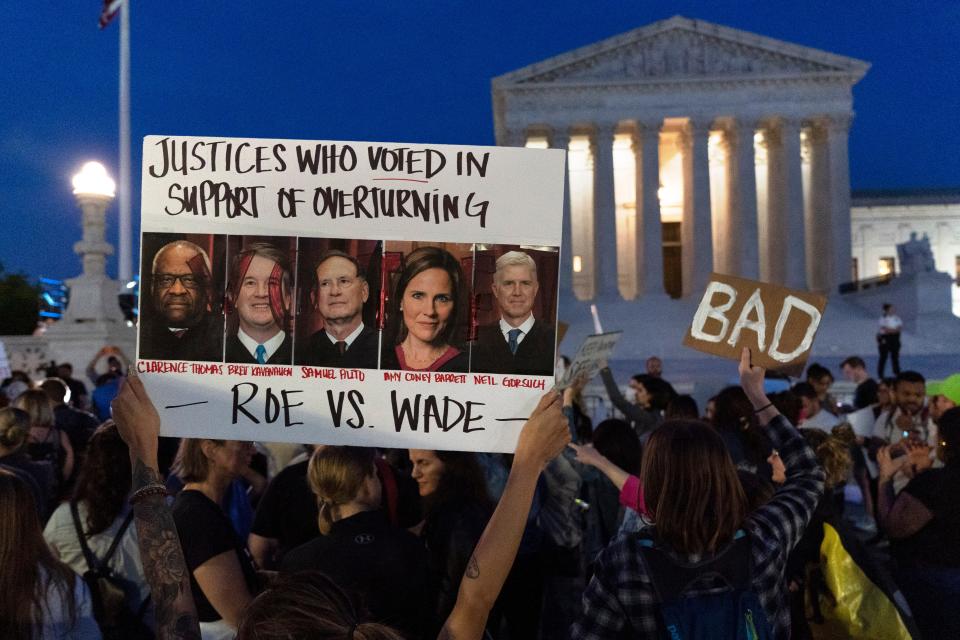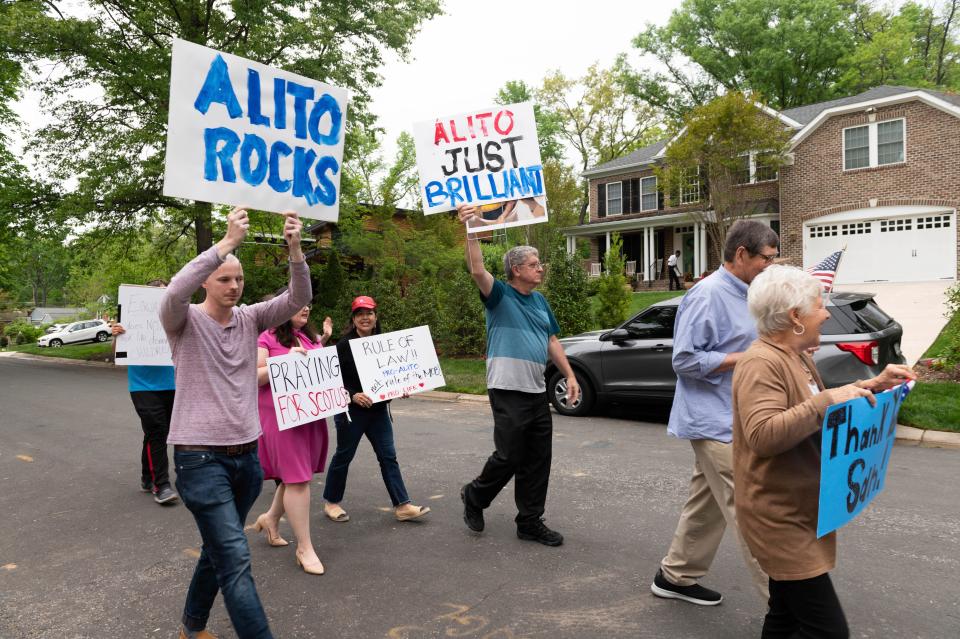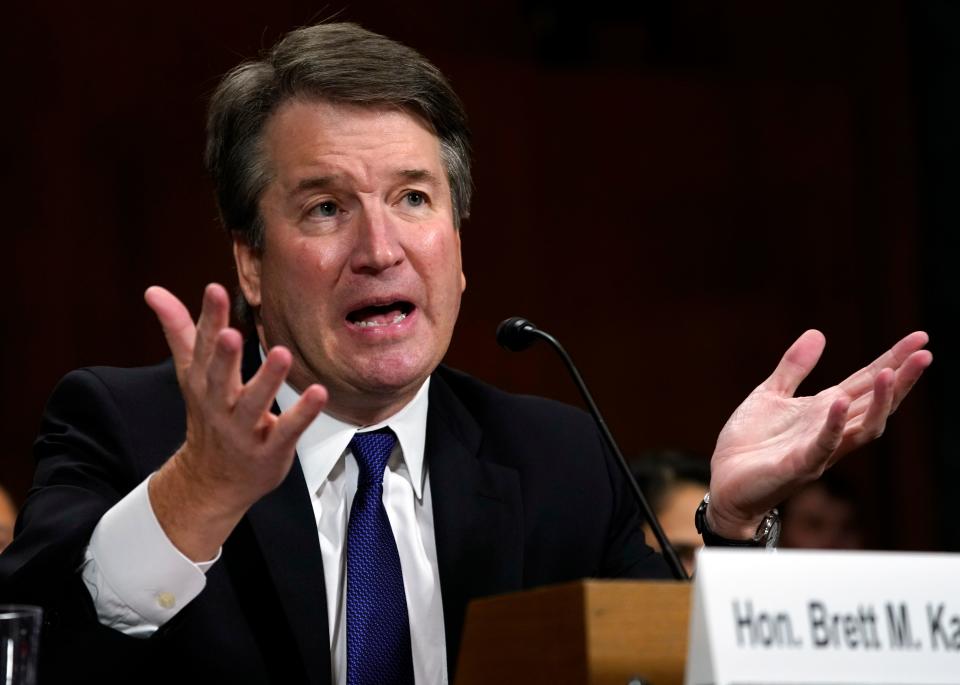Abortion rights protests that started at Supreme Court steps move to justices' front doorsteps
- Oops!Something went wrong.Please try again later.
- Oops!Something went wrong.Please try again later.
- Oops!Something went wrong.Please try again later.
The abortion rights demonstrations that started on the steps of the Supreme Court and the U.S. Capitol last week to protest an expected high court ruling overturning Roe v. Wade now have shifted to the front lawns of the justices themselves.
The group ShutDownDC has organized protests outside the homes of three conservative Supreme Court justices with more expected to follow. Over the weekend, about 100 protesters demonstrated outside the homes of Chief Justice John Roberts and Associate Justice Brett Kavanaugh, according to the group’s Twitter account.
And the group was behind the Monday protest outside the home of Associate Justice Samuel Alito, saying on its website that it has “been impossible to reach him at the Supreme Court” and citing new fencing erected at the court after the leaked opinion sparked demonstrations there. Alito's name appears on the leaked draft of the opinion that would do away with Roe after 49 years.
Taking protests to the justices' homes has been criticized by conservatives and the media but also raised concerns about the security of the nine justices who serve on the nation's high court amid an atmosphere of rising threats against judges nationwide.
Economic fallout: What the end of Roe v. Wade could mean in a nation without child care aid or family leave

Senate passes extra security for SCOTUS family members
As protesters marched to Alito's home Monday night, U.S. senators passed a bill that would expand security protection to the family members of Supreme Court justices. The bill now moves to the House.
Sens. Chris Coons, D-Del., and John Cornyn, R-Texas, introduced the Supreme Court Police Parity Act a week after the draft opinion leaked suggesting the high court has the votes to overturn Roe v. Wade.
"The events of the past week have intensified the focus on Supreme Court Justices' families, who are unfortunately facing threats to their safety in today's increasingly polarized political climate," Cornyn said in a statement.
Coons added that if families of justices have the same exposure, they deserve the same level of protection.
"We must take threats that come from extremes on both sides of the political spectrum against Supreme Court Justices seriously, and that makes this bill an unfortunate necessity," Coons said in a statement.
The bill comes days after U.S. Capitol Police said they were bracing for potential security risks.
Concrete barriers have been set up to block the street in front of the court, and a nonscalable fence was placed around the Supreme Court building.
How the justices were being protected was not immediately clear.
A court spokesperson did not respond to questions about security measures taken in response to the leaked draft and said that, as a matter of policy, the court does not discuss security arrangements.
'Urgent as it gets': See what's in the Senate bill protecting abortion rights
Protesters march to Alito's home

Police were guarding Alito's lawn when protesters arrived Monday night.
The demonstration outside Alito’s home was billed as a candlelit vigil. ShutDownDC planned to meet at a nearby location, march to his home, light candles and listen to speakers before marching back, according to its website.
Some in the crowd yelled, "Shame! Shame!"
Alito also attracted counterprotesters who carried signs of support, such as "Alito rocks" and "Alito just brilliant" and simple thank-you's.

While the protests have been largely peaceful, they have raised security concerns and questions of legality.
One organizer of protests outside Kavanaugh's home in Chevy Chase, Maryland, was one of his own neighbors. She told The Washington Post she has organized several demonstrations outside Kavanaugh's home.
Protesters on Saturday stood in the rain to chant outside the homes of Kavanaugh and Roberts, according to local television coverage of the demonstrations.
They chanted “no uterus, no opinion” outside Kavanaugh’s house and “the world is watching” outside Roberts’ home, according to the CBS affiliate WUSA. Some held signs with slogans like “Abortion saved my family” and “pregnancy begins with a penis.”
The demonstrations drew condemnation from some Republicans in Congress and in conservative media.
“When can we expect (Attorney General Merrick) Garland’s memo condemning protests at Supreme Court Justices’ homes,” Rep. Jim Jordan, R-Ohio, asked in a tweet on Monday afternoon.

Asked about protests at the homes of justices last week, White House press secretary Jen Psaki said that protests should be peaceful and respect privacy but that she didn’t “have an official U.S. government position on where people should protest.”
On Monday morning, she tweeted that President Joe Biden supports the right to protest without “violence, threats or vandalism.”
“Judges perform an incredibly important function in our society, and they must be able to do their jobs without concern for their personal safety,” she said.
Senate Minority Leader Mitch McConnell, R-Ky., said the protests outside the justices' homes might be "flat-out illegal."
"Trying to scare federal judges into ruling a certain way is far outside the bounds of First Amendment speech or protest," he said on the Senate floor Monday. "It's an attempt to replace the rule of law with the rule of mobs."
Contributing: John Fritze.
Candy Woodall is a Congress reporter for USA TODAY. She can be reached at cwoodall@usatoday.com or on Twitter at @candynotcandace.
This coverage is only possible with support from our readers. Sign up today for a digital subscription.
This article originally appeared on USA TODAY: Abortion protests move from Supreme Court to justices' homes

